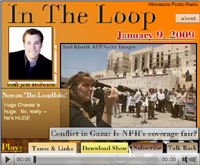 CAMERA Senior Research Analyst Gilead Ini appeared on Minnesota Public Radio’s In The Loop on Jan. 9, 2009 to discuss NPR’s coverage of the conflict in Gaza. To listen to the program as broadcast, visit the In The Loop Web site by clicking here. The NPR discussion begins 13 minutes into the program. In the Loop had also released an unedited version of the interview, which you can listen to below.
CAMERA Senior Research Analyst Gilead Ini appeared on Minnesota Public Radio’s In The Loop on Jan. 9, 2009 to discuss NPR’s coverage of the conflict in Gaza. To listen to the program as broadcast, visit the In The Loop Web site by clicking here. The NPR discussion begins 13 minutes into the program. In the Loop had also released an unedited version of the interview, which you can listen to below.
The longer, unedited version of the interview includes several falsehoods and misleading statements by pro-Palestinian activist Ali Abunimah, who was also interviewed.
Abunimah, a founder of the anti-Israel Electronic Intifada Web site, tells listeners that “according to various media reports,” Palestinian rockets “carry about a charge, or an explosive charge, of about two pounds” of TNT. In fact, only a week before the interview aired, the Associated Press reported that the Qassam “carries a small warhead of about 22 pounds of explosives” (1/2/09, Hamza Hendawi, “Rockets are again at the heart of a Mideast war”).
In other words, according to current media reports, the current Qassam rocket carries 11 times more TNT than the amount clamed by Abunimah. (Even as far back as 2003, when the rockets were less powerful than they are today, AP estimated the weight of the warhead to be 12 pounds. See, e.g., 5/9/03, “Palestinians fire six rockets at Israel, injuring girl.”) And the more sophisticated Grad rockets that Palestinians occasionally fire into Israel are estimated to carry warheads of roughly 40 pounds, or 20 times higher than what Abunimah tells listeners.
He also claims that “the images that you see on the front page [of the New York Times], it’s like almost 1 to 1, or even more images of mourning Israelis.” He argues that because more Palestinian children were killed, coverage “is not balanced.” This allegation, too, is transparently false. According to a New York Times count of photos through the day the MRP interview was aired, the newspaper published in all its pages “three photos from Gaza showing the impact of the war for every photo from Israel. There were 28 photos, some quite graphic, of dead and wounded Palestinians, five of Israelis.”
And CAMERA’s count of New York Times front page images from the start of fighting through the day of the interview found that there were four pictures of Palestinian casualties, one picture of a destroyed Palestinian building, and one of a young Palestinian boy fleeing Gaza. During that same time period, the newspaper published on its front page one photo of an Israeli tank and two photos of Israeli soldiers — in the field, and not mourning. If anything, this selection of photographs distorts readers’ understanding by giving the impression that this is a battle between Israeli soldiers and Palestinian civilians. There were no front page photos of Hamas fighters, nor any of Israeli civilians or soldiers injured in the fighting.
Also disingenuous was Abunimah’s assertion that “Israel was forced to retract” its claim that Palestinian mortars were fired from a UN school that was hit by Israeli return fire. Israel had not retracted its claim. Israel’s first response — which it stressed was only an initial inquiry — was that “mortar shells were fired at IDF forces from within the Jebaliya school.” Although a UN official later claimed that unnamed Israeli officers said the Palestinian fighters were not actually inside the school, and a subsequent news report asserted that the Palestinians fired mortars at Israel from an area “adjacent to” the school, these new claims do not amount to an Israeli retraction, but, if anything, a later update to what was clearly described as an “initial inquiry.”
Indeed, they are very much in line with Israel’s position that it was responding to Palestinian mortar fire from a civilian area. This position, moreover, is backed by two Palestinian witnesses who told the Associated Press that they “saw a small group of militants firing mortar rounds from a street near the school,” and another witness who told the New York Times that he saw a Palestinian fighter in the area right before the Israeli attack.
